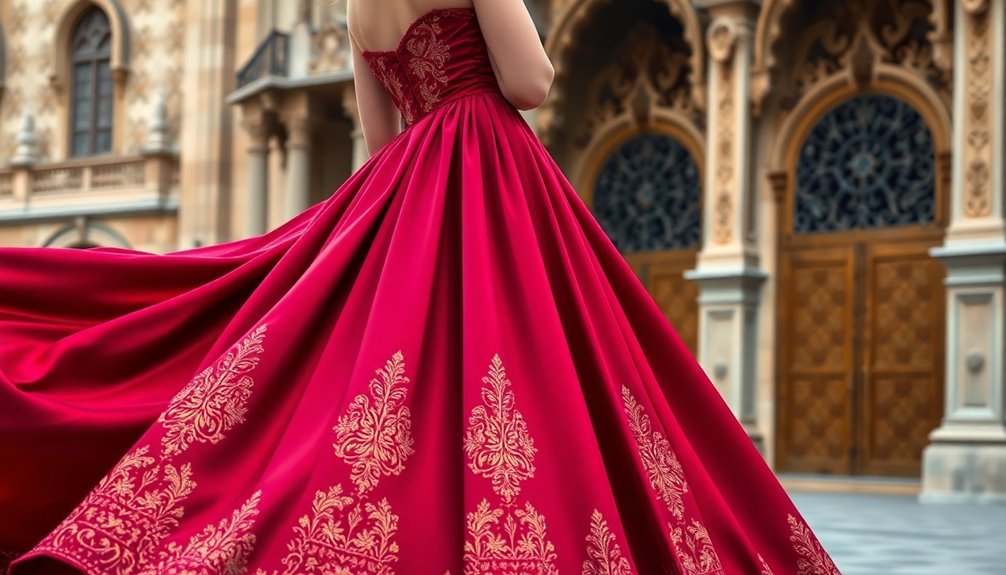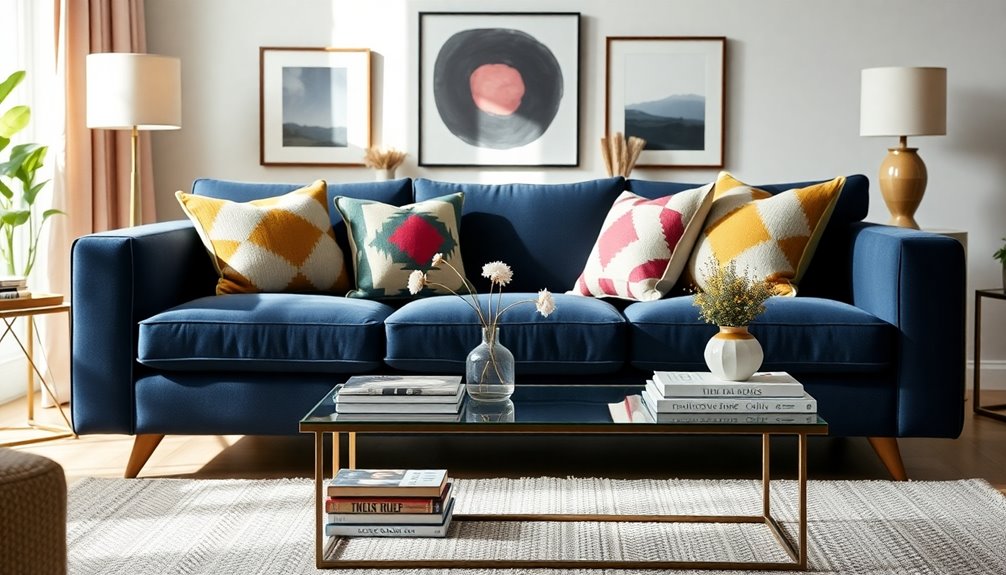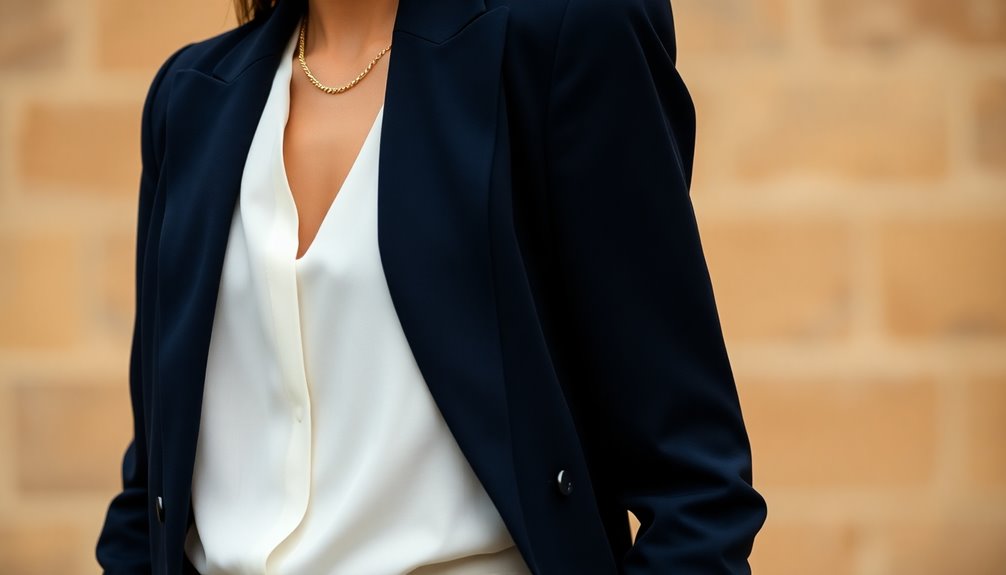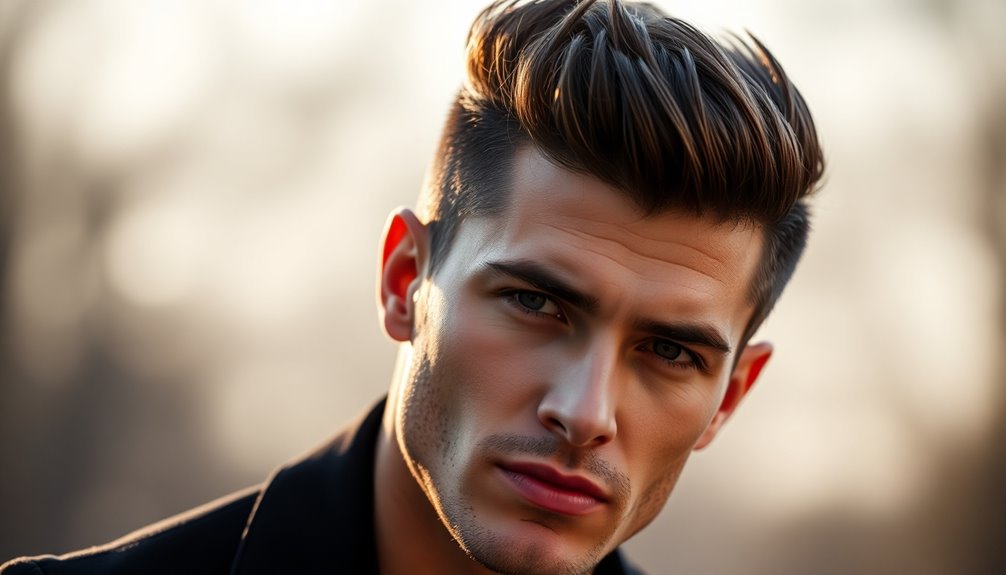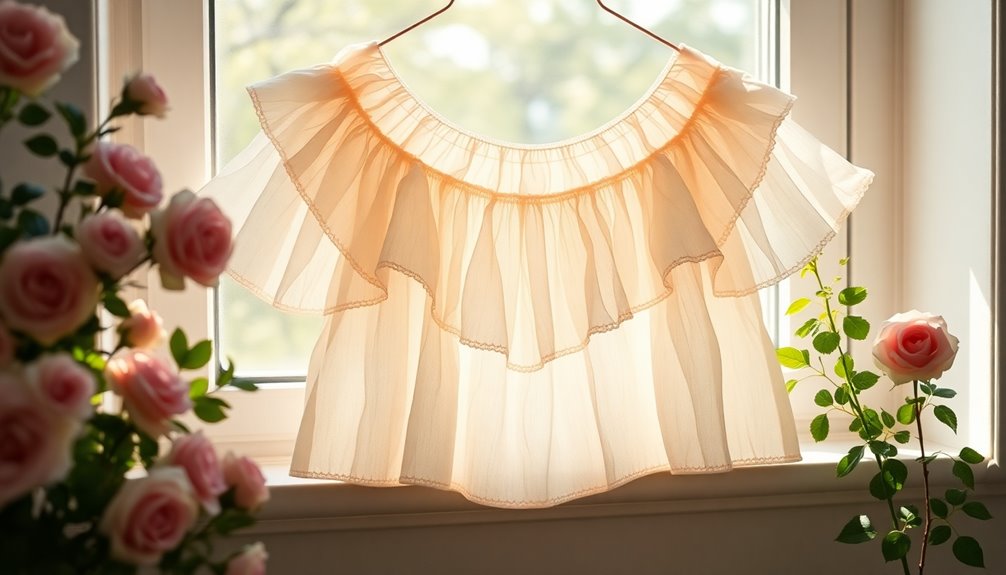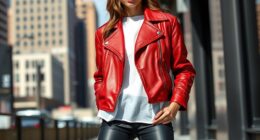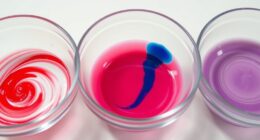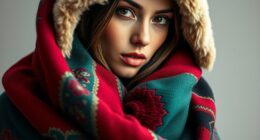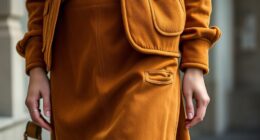The Spanish gown embodies regal drapery, drawing inspiration from rich Iberian heritage. You'll notice exquisite embroidery, vibrant colors, and luxurious fabrics like silk that enhance its elegance. Influenced by Moorish architecture and the opulence of the Rococo period, each gown tells a story of cultural blending. The modern interpretation often showcases sustainable practices, marrying tradition with contemporary design. To style your gown, consider layering with rich accessories and structured elements. Explore the artistry in hand-stitched embellishments that capture this enchanting heritage. There's so much more to discover about its historical significance and modern trends in fashion.
Key Takeaways
- Spanish gowns showcase regal drapery, characterized by luxurious silk and intricate embellishments reflecting Iberian heritage and nobility.
- Rich embroidery patterns, often featuring floral and geometric motifs, celebrate Spain's diverse cultural influences and craftsmanship.
- Signature features like voluminous sleeves and lace capes enhance the gown's elegance, merging traditional and contemporary design elements.
- Modern Spanish gowns emphasize sustainable practices, using eco-friendly materials while maintaining the opulence associated with Iberian fashion heritage.
- The revival of artisanal craftsmanship in regions like Andalusia highlights the cultural significance and modern relevance of Spanish gowns in today's fashion.
Origin and historical background of the fashion trend/style
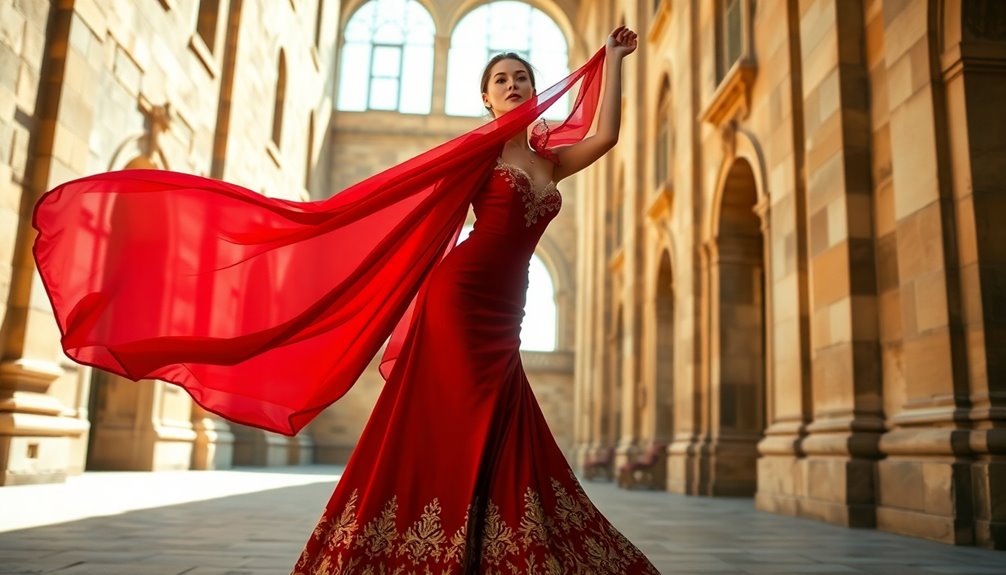
The Spanish gown represents a fascinating transformation in fashion, reflecting the intricate blend of cultural influences throughout history.
You'll notice how Moorish architectural elements inspired its lavish designs, adding a unique flair to the gowns' structure.
This evolution not only showcased the nobility's wealth but also highlighted the rich tapestry of Spain's artistic heritage.
Historical Fashion Transformation
During the Spanish Golden Age, nobles donned elaborate garments that would eventually evolve into the iconic Spanish gown we recognize today. These gowns reflected the wealth and power of the Iberian Peninsula, showcasing rich fabrics like silk and brocade. The intricate embroidery and lace added a touch of artistry, emphasizing the cultural exchanges between Spain and its colonies.
As time progressed, the design of the Spanish gown transformed significantly. In the 16th century, the introduction of the farthingale expanded the silhouette, accentuating a woman's stature and elegance. This dramatic change set the stage for further evolution in fashion.
By the 18th century, Spanish gowns were heavily influenced by the Rococo style, showcasing elaborate patterns and vibrant colors. This era emphasized opulence and theatricality, making fashion a statement of status and personality.
Today, the modern interpretation of the Spanish gown still draws from these historical elements. It maintains a sense of heritage while embracing contemporary fashion trends, making it a popular choice for formal events and bridal wear.
Moorish Architectural Elements
Moorish architectural elements significantly shaped the evolution of Spanish fashion, particularly in the design of gowns. Flourishing during the Islamic rule from the 8th to 15th centuries, these elements introduced intricate geometric patterns and arabesques that became hallmarks of Spanish textiles.
You can see the influence of luxurious fabrics and elaborate drapery in gowns, mirroring the opulence of Moorish palaces, where textiles featured designs echoing the ornate tile work and stuccos of their architecture.
As you explore fashion today, you'll notice how key features of Moorish architecture, like horseshoe arches and ornate columns, inspire gown silhouettes that reflect the flowing lines and grandeur found in structures like the Alhambra.
The blending of Islamic and Christian cultures during the Reconquista further enriched this fusion, showcasing rich embroidery and embellishments reminiscent of architectural motifs.
Additionally, the layering concept and the use of draped fabrics in contemporary Spanish fashion connect back to the functional and aesthetic aspects of Moorish design, which emphasized both beauty and practicality.
This historical interplay continues to influence modern interpretations, making these gowns not just garments, but a celebration of a rich cultural heritage.
Key Characteristics
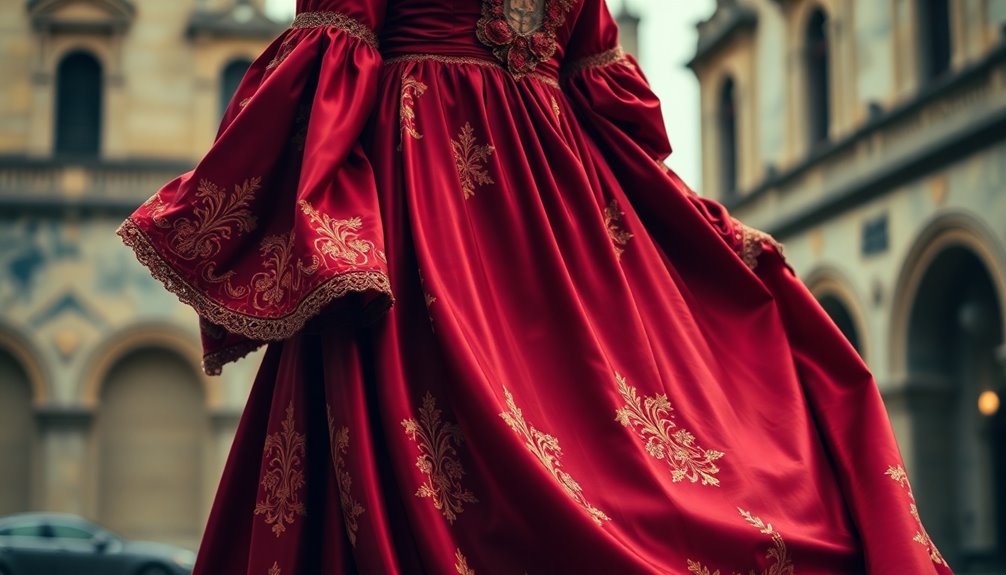
When you think of Spanish gowns, imagine rich embroidery patterns that tell a story of tradition and artistry.
The lustrous silk in deep burgundy creates a striking visual impact, elevating the overall elegance of the design.
Add signature lace capes, and you've got a look that beautifully blends history with modern flair.
Rich Embroidery Patterns
Rich embroidery patterns in Spanish gowns showcase a blend of intricate designs that reflect the country's diverse cultural heritage.
You'll notice how these patterns draw inspiration from both Moorish and Christian artistic traditions, creating a unique visual narrative. Common motifs include floral designs, geometric shapes, and religious symbols, each hand-stitched to highlight artisanal craftsmanship and attention to detail.
When you examine the gowns, the vibrant color palettes come alive, featuring deep reds, golds, and blues that enhance the embroidery's visual impact, making these garments striking and memorable.
Techniques like satin stitch, chain stitch, and appliqué add texture and dimension, allowing the embroidery to stand out even more.
You might find regional variations in embroidery styles as well, with distinct characteristics emerging from areas like Andalusia, Catalonia, and Galicia.
Each region contributes its own flavor to the overall design, showcasing Spain's rich tapestry of cultural influences. This variety not only celebrates the nation's history but also accentuates the elegance of the Spanish gown, making each piece a true work of art.
Lustrous Silk and Deep Burgundy
The allure of lustrous silk in Spanish gowns creates an immediate sense of elegance and sophistication. This luxurious material is celebrated for its beautiful sheen and graceful drape, enhancing the overall regal appearance of the attire. When you wear a gown crafted from silk, you'll feel the fabric's soft touch against your skin, elevating your style to new heights.
Deep burgundy, a favored color in Spanish fashion, plays a significant role in these designs. This rich hue symbolizes nobility and sophistication, echoing the grandeur of Spain's historical royal courts. As you don this color, you connect with centuries of cultural heritage that informs each gown.
The craftsmanship involved in creating these gowns is nothing short of extraordinary. Intricate details like hand-embroidery and embellishments showcase traditional Iberian artistry, making each piece a work of art.
The flowing drapery not only enhances the silhouette but also allows for graceful movement, embodying the essence of Spanish femininity.
In essence, the combination of lustrous silk and deep burgundy encapsulates the spirit of Spanish gowns, inviting you to revel in their beauty and heritage.
Signature Lace Capes
Building on the elegance of lustrous silk and deep burgundy, signature lace capes add a distinct layer of sophistication to Spanish gowns. These capes often showcase intricate handmade lace patterns, highlighting the exceptional craftsmanship from regions like Galicia and Catalonia.
You'll appreciate how these designs reflect Spain's rich textile heritage. Adorned with elaborate embroidery, including floral motifs and traditional symbols, these capes capture diverse cultural influences and historical nuances. The luxurious fabrics—silk, satin, and brocade—enhance the regal aesthetic, ensuring that high-quality materials shine in Iberian fashion.
Regional variations make lace capes even more captivating. For instance, styles from Andalusia embrace bold colors and dramatic silhouettes, while those from Valencia lean towards delicate, lighter fabrics for a softer appearance.
This versatility allows you to style the capes in multiple ways, whether draping them elegantly over your shoulders or creating a stunning train effect. Ultimately, signature lace capes serve as essential layering pieces, making them a popular choice for both traditional and contemporary bridal fashion, ensuring you stand out on your special day.
Modern Interpretation
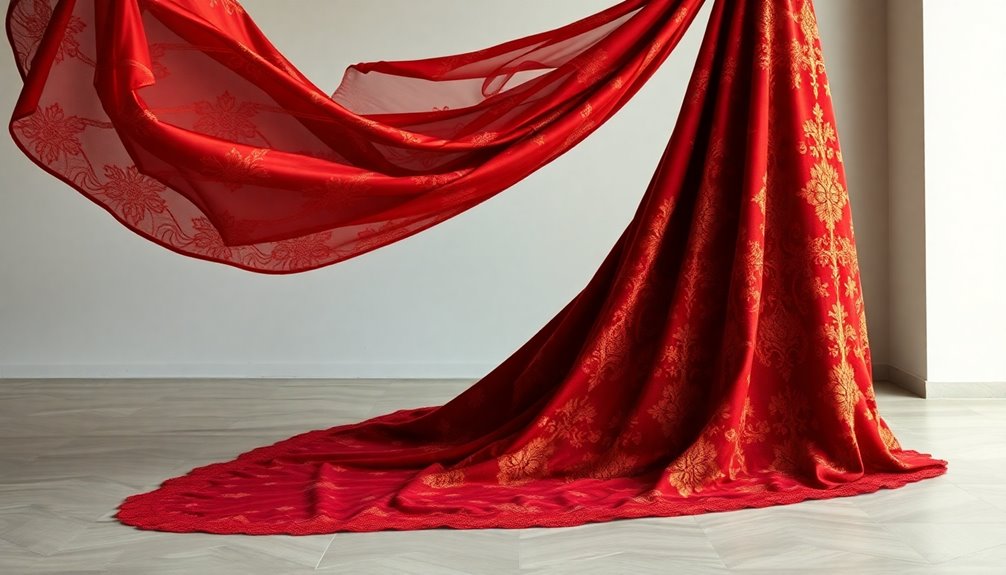
When you explore modern Spanish gowns, you'll notice a shift towards sustainable fabric choices that reflect a commitment to eco-friendly fashion.
Renowned Iberian fashion houses are leading this movement, blending traditional craftsmanship with innovative techniques.
You'll also find fashion icons of Iberian heritage showcasing these stunning designs, proving that elegance can align with ethical practices.
Sustainable Fabric Choices
Embracing sustainable fabric choices has become essential in modern Spanish gown design, reflecting a growing commitment to environmental responsibility. Designers are increasingly opting for materials like organic cotton, linen, and Tencel, which are biodegradable and produced with minimal environmental impact. This shift not only enhances the aesthetics of the gowns but also aligns with eco-conscious values.
You might notice that many creators are now using recycled polyester, derived from plastic bottles, which reduces waste and promotes a circular fashion economy. Innovations in eco-friendly dyeing techniques are also on the rise, with natural dyes sourced from plants and minerals minimizing harmful chemical usage in the production process.
Supporting local textile production is another key focus. By sourcing materials regionally, designers reduce their carbon footprints associated with transportation and empower local artisans, preserving traditional craft techniques.
Plus, with increasing consumer awareness and demand for sustainability, Spanish designers are prioritizing transparency in their sourcing and manufacturing processes. By doing so, they not only showcase their commitment to ethical practices but also inspire you to make more informed choices in your fashion selections.
Renowned Iberian Fashion Houses
Renowned Iberian fashion houses like Manuel Mota and Pronovias have redefined the landscape of modern Spanish gowns, seamlessly weaving traditional elements into contemporary designs. Their collections beautifully blend intricate lace and bold silhouettes, drawing on Spain's rich cultural heritage.
You'll notice luxurious fabrics like silk and satin, which showcase the artisanal techniques that define Iberian craftsmanship.
Fashion events such as Barcelona Bridal Fashion Week highlight these innovative designers, demonstrating their knack for merging traditional aesthetics with modern flair. You'll see classic features reimagined in ways that appeal to a global audience, making these gowns not just garments but statements of identity.
Moreover, many of these fashion houses focus on sustainability, incorporating eco-friendly practices while maintaining high-quality craftsmanship. This commitment adds depth to their designs, ensuring that each piece isn't only stunning but also responsibly made.
Regional influences, like flamenco-inspired ruffles and vibrant color palettes, remain integral to the collections of these leading designers. By celebrating the diverse cultural identities of the Iberian Peninsula, they continue to inspire and captivate fashion enthusiasts worldwide, making modern Spanish gowns truly exceptional.
Fashion Icons of Iberian Heritage
Iberian heritage finds a modern voice through a new generation of fashion icons who skillfully blend tradition and innovation. Designers like Pedro del Hierro and Ana Locking are at the forefront, reinterpreting classic Iberian silhouettes with a contemporary flair.
You'll notice how they incorporate intricate embroidery, luxurious fabrics, and bold colors that pay homage to the rich cultural history of Spain and Portugal.
Their collections often feature motifs inspired by Spanish art and architecture. Look for azulejos patterns and dramatic drapery reminiscent of Baroque styles, which add depth to their designs. These elements not only resonate with heritage but also capture the eye of modern audiences.
Eco-conscious designers emerging from the Iberian Peninsula emphasize sustainability, sourcing materials locally, and promoting artisanal craftsmanship that's deeply rooted in regional traditions.
The recent resurgence of interest in Iberian fashion has sparked collaborations between modern designers and traditional artisans. This fusion preserves cultural heritage while appealing to a global market.
As you explore these fashion icons, appreciate how they honor the past while paving the way for the future of Iberian style.
Styling Tips
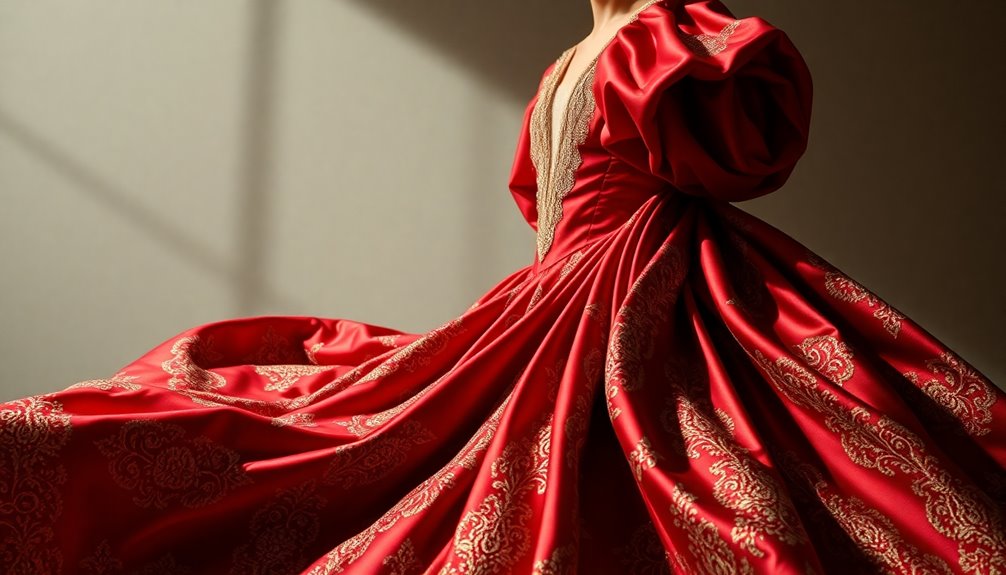
When styling your Spanish gown, think about incorporating essential Iberian accessories that elevate your look.
Pair your gown with traditional Spanish shawls to add warmth and depth, while also mixing textures and patterns for a dynamic visual appeal.
These elements not only enhance your outfit but also celebrate the rich heritage of Spanish and Portuguese fashion. Incorporating these elements into your wardrobe can truly transform your style, allowing you to embrace the bold colors and intricate patterns characteristic of this cultural legacy. The spaniard dress vibrant fashion can be seen in the stunning embroidery and exquisite fabrics that reflect the warmth and diversity of Iberian culture. By blending these traditional elements with modern design, you create a unique look that pays homage to history while staying fashion-forward.
Essential Iberian Accessories
To elevate your Spanish gown and truly embody the essence of regal elegance, consider incorporating essential accessories that reflect the rich cultural heritage of the region.
Start with a richly embroidered cloak or cape, crafted from luxurious fabrics like velvet or brocade. This addition not only provides warmth but also adds that regal touch reminiscent of traditional Iberian attire.
Next, enhance your look with intricate gold and silver jewelry. Choose earrings and necklaces featuring religious or cultural symbols that echo the opulence of Iberian heritage. These adornments can elevate your gown's elegance significantly.
Don't forget a decorative hand fan; a beautifully painted or lace-adorned fan adds sophistication and charm while nodding to traditional Spanish customs.
For your hair, consider wearing an ornate headpiece or a traditional "mantilla" lace veil that complements your gown and pays homage to Iberian bridal traditions.
Finally, select elegant footwear, like embellished espadrilles or heeled sandals. These shouldn't only match the aesthetic of your gown but also provide comfort and style, ensuring you feel regal from head to toe.
With these accessories, you'll truly shine in your Spanish gown.
Traditional Spanish Shawl Pairings
A stunning Spanish shawl, or "mantón," can transform your regal gown into a masterpiece of cultural elegance. Made from luxurious fabrics like silk or wool, mantones often feature intricate embroidery that perfectly complements the opulence of your gown.
To enhance the overall aesthetic, choose a mantón in bold colors or patterns that add vibrancy and a touch of Iberian heritage.
When styling your mantón, consider draping it gracefully over your shoulders or wrapping it around your waist. This layering technique not only emphasizes the gown's silhouette but also adds an air of sophistication. The fringes common on Spanish shawls can introduce movement and texture, making them ideal for both formal events and festive occasions.
To create a visually striking bridal ensemble, select a mantón that harmonizes with your gown's color palette and embroidery. This thoughtful pairing reflects the rich traditions of Iberian fashion while ensuring a cohesive look.
Combining Textures and Patterns
Elevating your regal gown involves more than just choosing the right mantón; it's about combining textures and patterns that create a stunning visual impact.
Start by layering luxurious fabrics like silk and velvet, topped with intricate lace overlays. This adds depth and reflects the opulence of Iberian heritage.
Next, don't shy away from pattern mixing. Traditional Spanish motifs—floral and geometric—paired with solid fabrics enhance your gown's regal aesthetic while maintaining a sense of harmony.
When it comes to color, opt for rich, bold hues like deep reds, royal blues, and gold accents, as these evoke the grandeur of historical garments.
To truly stand out, incorporate embellishments like hand-stitched embroidery, sequins, or beading. These details highlight craftsmanship and create striking focal points on your gown.
Finally, consider adding structural elements—voluminous sleeves or dramatic capes can evoke the grandeur of traditional Spanish attire, giving your modern look an elegant twist.
Shopping Guide
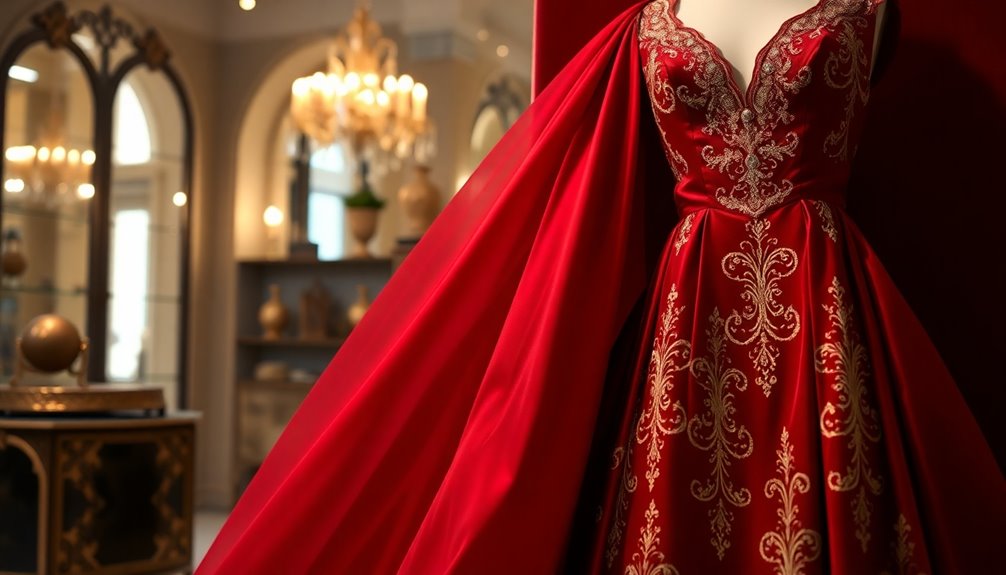
When you're on the hunt for a Spanish gown, keep an eye out for luxurious fabrics like silk, satin, and brocade that embody regal drapery inspired by Iberian heritage. These materials not only create a stunning silhouette but also reflect the opulence of traditional Spanish fashion.
Look for designs featuring intricate lace and embroidery, especially those adorned with floral motifs or religious symbols, which showcase the craftsmanship typical of Spanish bridal wear.
Explore regional variations to discover unique styles. Gowns from Andalusia often boast bold colors and ornate details, while Castilian designs might emphasize elegance and simplicity. Each piece carries a historical significance that adds depth to your choice.
Don't overlook the option of custom gowns. Local designers specializing in bridal wear can blend traditional Spanish elements with modern aesthetics, ensuring a personalized experience.
Additionally, consider brands that prioritize sustainable practices. Opting for eco-friendly materials and artisanal techniques aligns your choice with the growing trend of conscious fashion in the bridal industry.
Embrace the beauty of Spanish gowns while making mindful decisions that reflect your values.
Handcrafted Embellishments and Techniques
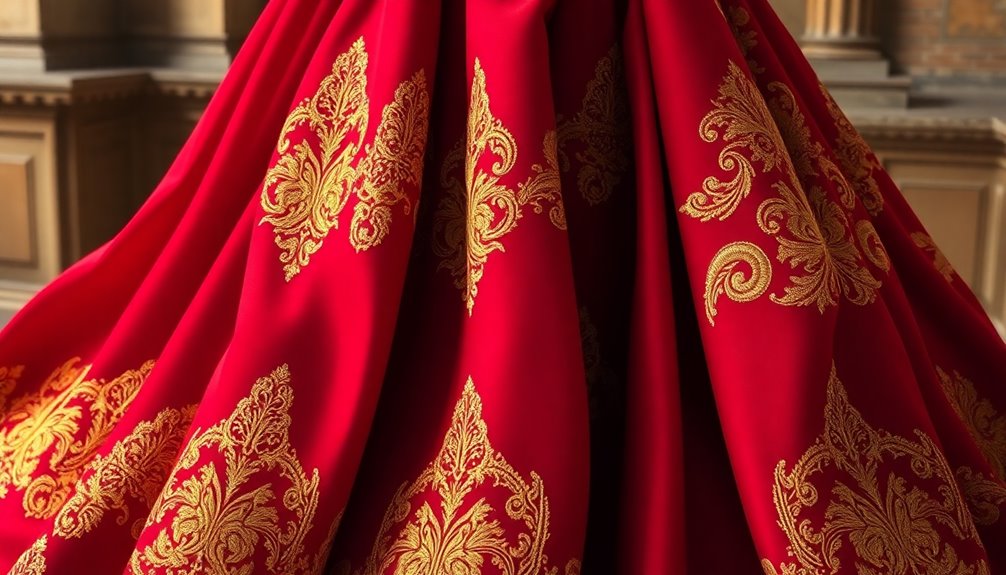
When you think about Spanish gowns, the handcrafted lace detailing and personalized embroidery options stand out as key features.
These intricate techniques not only enhance the gown's beauty but also reflect the rich cultural traditions behind each piece.
Handcrafted Lace Detailing Techniques
Handcrafted lace detailing transforms Spanish gowns into stunning works of art, showcasing the skill and creativity of artisans. You'll often find traditional techniques like bobbin lace-making, where threads weave over bobbins to create intricate patterns that leave a lasting impression.
Each piece embodies the rich Iberian heritage through motifs like floral designs and geometric shapes, reflecting the culture's vibrant history. Artisans use high-quality materials such as cotton and silk, ensuring durability and elegance in every gown.
The delicate lace isn't just an afterthought; it's meticulously hand-stitched onto the fabric, allowing for a customized touch that makes each gown unique. This level of craftsmanship requires immense dedication, often taking weeks or even months to complete.
When you wear a gown adorned with handcrafted lace, you're not just donning a dress; you're embracing a piece of art, a story woven into the fabric. The intricate detailing adds depth and character, making each gown a true representation of traditional Spanish artistry. Additionally, the use of natural materials in crafting these gowns not only enhances their beauty but also supports eco-friendly practices in the fashion industry.
Personalized Embroidery Options
In the realm of Spanish gowns, personalized embroidery options elevate your attire to new heights of artistry and significance. These intricate designs often reflect regional heritage, featuring floral patterns or traditional symbols specific to different areas of Spain.
Each gown showcases handcrafted embellishments created through artisanal techniques passed down through generations, ensuring that your gown is unique and steeped in cultural meaning.
Popular techniques include hand-stitching with gold or silver threads, adding luxurious details that enhance the regal aesthetic of your gown. You can also incorporate personal elements, like your initials or wedding date, transforming the gown into a cherished keepsake that tells your unique story.
This personal touch not only makes the gown special but also connects you to the rich traditions of Spanish craftsmanship.
Many designers prioritize high-quality, sustainable materials for their embroidery, aligning with eco-friendly practices while preserving the artistry of Spanish gown embellishments.
Cultural Impact
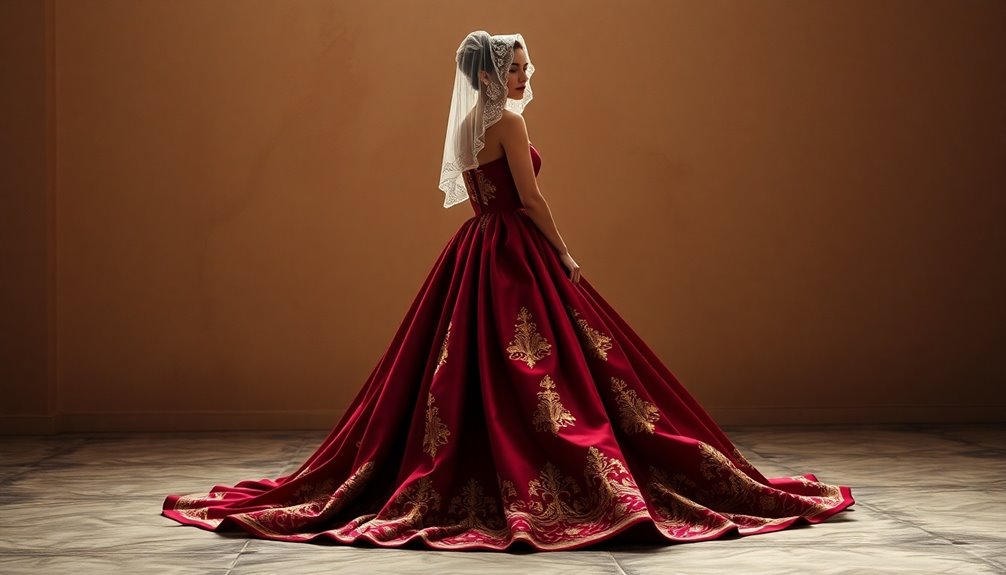
The Spanish gown's influence on fashion is significant, especially in how it inspires modern designs and bridal wear.
You can see echoes of its regal drapery in contemporary styles, reinforcing cultural pride and identity.
Additionally, the gown has become a symbol in feminist fashion advocacy, showcasing how traditional attire can empower women while embracing their heritage.
Carmen's Influence on Fashion
Carmen's vibrant spirit has left an indelible mark on the world of fashion, inspiring designers to embrace the essence of Spanish culture. This iconic character, from Prosper Mérimée's novella and Georges Bizet's opera, embodies a passionate and free-spirited nature that resonates through the garments she inspires.
You'll often find flamenco-inspired elements like ruffles and bold colors in contemporary collections, as designers seek to capture her essence.
Carmen's portrayal has also commercialized traditional Spanish attire, bringing mantillas and flamenco dresses into the global spotlight. This shift has significantly influenced how Spanish fashion is perceived worldwide. Designers frequently draw upon her motifs of strength and femininity, creating modern interpretations that honor the cultural significance of these garments.
Moreover, her legacy has sparked a revival of interest in artisanal craftsmanship, especially in regions like Andalusia, where traditional dressmaking and embroidery techniques thrive.
As you explore the world of fashion, you'll notice how Carmen continues to inspire creativity, reminding us of the rich heritage and artistry that define Spanish style. Embracing her influence, designers celebrate a vibrant cultural history while pushing the boundaries of modern fashion.
Feminist Fashion Advocacy
Fashion's evolution continues to reflect broader societal movements, with feminist fashion advocacy at the forefront of this change. This movement challenges traditional gender roles, promoting empowerment through clothing choices that celebrate women's strength and individuality. The Spanish gown exemplifies this ethos, showcasing regal drapery that honors women's heritage while fostering body positivity and confidence.
By integrating traditional Iberian elements into contemporary designs, fashion creators emphasize the importance of cultural identity within feminist narratives. This connection fosters pride and belonging among women, encouraging them to embrace their roots while asserting their place in modern society.
Feminist fashion initiatives also prioritize sustainability, urging consumers to invest in high-quality pieces like the Spanish gown. These timeless garments transcend fleeting trends, reinforcing the value of thoughtful consumption. Additionally, the rise of Nike Tech in sneaker culture illustrates how modern brands are increasingly aligning with social movements, emphasizing comfort and style that resonates with the empowerment narrative.
Inclusivity is a cornerstone of feminist fashion advocacy. It champions diverse body types and representations, ensuring all women feel seen and valued. The adaptation of designs like the Spanish gown reflects this commitment to inclusivity, allowing every woman to experience the empowerment that comes from wearing clothing that resonates with her identity.
Through these efforts, feminist fashion advocacy reshapes the cultural landscape, promoting a more equitable future.
Frequently Asked Questions
What Does a Black Wedding Dress Mean in Spain?
A black wedding dress in Spain symbolizes more than just a color; it represents elegance, sophistication, and a break from tradition.
When you choose a black gown, you embrace a rich cultural heritage that reflects both mourning and celebration.
In regions like the Basque Country, these dresses often feature vibrant embroidery, showcasing local customs.
Who Is the Best Gown Designer?
When you're looking for the best gown designer, it really depends on your style and needs.
If you want elegance, Pronovias is a fantastic choice for bridal gowns.
For bold and innovative designs, Ana Locking stands out.
If luxury and architectural draping are what you seek, Balenciaga is renowned for its modern takes.
Ultimately, you should explore these options to find the designer whose vision resonates with your personal taste and occasion.
Is Pronovias a Spanish Brand?
Yes, Pronovias is a Spanish brand. Founded in 1922 in Barcelona, it's renowned for its luxurious bridal and evening wear.
You'll find that Pronovias combines traditional Spanish craftsmanship with modern elegance, appealing to brides worldwide.
With boutiques in over 105 countries, the brand showcases its rich heritage while embracing global trends.
Their commitment to sustainability also sets them apart, making Pronovias a favorite among fashion-conscious consumers who value eco-friendly practices.
